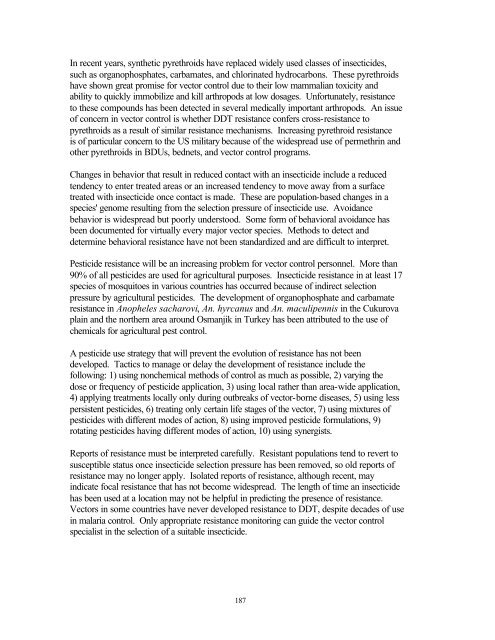Middle East DVEP - Armed Forces Pest Management Board
Middle East DVEP - Armed Forces Pest Management Board
Middle East DVEP - Armed Forces Pest Management Board
You also want an ePaper? Increase the reach of your titles
YUMPU automatically turns print PDFs into web optimized ePapers that Google loves.
In recent years, synthetic pyrethroids have replaced widely used classes of insecticides,such as organophosphates, carbamates, and chlorinated hydrocarbons. These pyrethroidshave shown great promise for vector control due to their low mammalian toxicity andability to quickly immobilize and kill arthropods at low dosages. Unfortunately, resistanceto these compounds has been detected in several medically important arthropods. An issueof concern in vector control is whether DDT resistance confers cross-resistance topyrethroids as a result of similar resistance mechanisms. Increasing pyrethroid resistanceis of particular concern to the US military because of the widespread use of permethrin andother pyrethroids in BDUs, bednets, and vector control programs.Changes in behavior that result in reduced contact with an insecticide include a reducedtendency to enter treated areas or an increased tendency to move away from a surfacetreated with insecticide once contact is made. These are population-based changes in aspecies' genome resulting from the selection pressure of insecticide use. Avoidancebehavior is widespread but poorly understood. Some form of behavioral avoidance hasbeen documented for virtually every major vector species. Methods to detect anddetermine behavioral resistance have not been standardized and are difficult to interpret.<strong>Pest</strong>icide resistance will be an increasing problem for vector control personnel. More than90% of all pesticides are used for agricultural purposes. Insecticide resistance in at least 17species of mosquitoes in various countries has occurred because of indirect selectionpressure by agricultural pesticides. The development of organophosphate and carbamateresistance in Anopheles sacharovi, An. hyrcanus and An. maculipennis in the Cukurovaplain and the northern area around Osmanjik in Turkey has been attributed to the use ofchemicals for agricultural pest control.A pesticide use strategy that will prevent the evolution of resistance has not beendeveloped. Tactics to manage or delay the development of resistance include thefollowing: 1) using nonchemical methods of control as much as possible, 2) varying thedose or frequency of pesticide application, 3) using local rather than area-wide application,4) applying treatments locally only during outbreaks of vector-borne diseases, 5) using lesspersistent pesticides, 6) treating only certain life stages of the vector, 7) using mixtures ofpesticides with different modes of action, 8) using improved pesticide formulations, 9)rotating pesticides having different modes of action, 10) using synergists.Reports of resistance must be interpreted carefully. Resistant populations tend to revert tosusceptible status once insecticide selection pressure has been removed, so old reports ofresistance may no longer apply. Isolated reports of resistance, although recent, mayindicate focal resistance that has not become widespread. The length of time an insecticidehas been used at a location may not be helpful in predicting the presence of resistance.Vectors in some countries have never developed resistance to DDT, despite decades of usein malaria control. Only appropriate resistance monitoring can guide the vector controlspecialist in the selection of a suitable insecticide.187

















